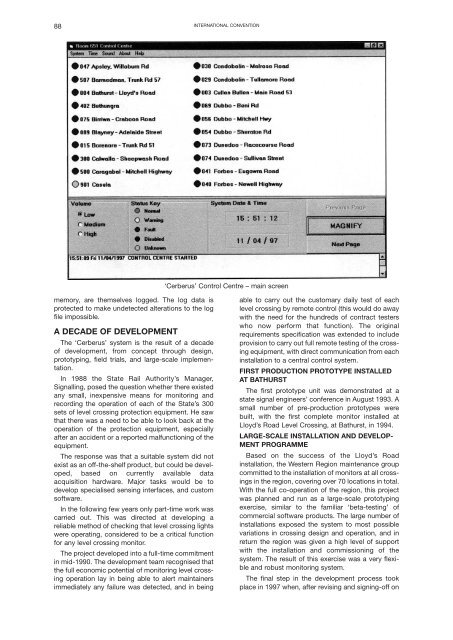Proceedings 2002/2003 - IRSE
Proceedings 2002/2003 - IRSE
Proceedings 2002/2003 - IRSE
You also want an ePaper? Increase the reach of your titles
YUMPU automatically turns print PDFs into web optimized ePapers that Google loves.
88<br />
INTERNATIONAL CONVENTION<br />
‘Cerberus’ Control Centre – main screen<br />
memory, are themselves logged. The log data is<br />
protected to make undetected alterations to the log<br />
file impossible.<br />
A DECADE OF DEVELOPMENT<br />
The ‘Cerberus’ system is the result of a decade<br />
of development, from concept through design,<br />
prototyping, field trials, and large-scale implementation.<br />
In 1988 the State Rail Authority’s Manager,<br />
Signalling, posed the question whether there existed<br />
any small, inexpensive means for monitoring and<br />
recording the operation of each of the State’s 300<br />
sets of level crossing protection equipment. He saw<br />
that there was a need to be able to look back at the<br />
operation of the protection equipment, especially<br />
after an accident or a reported malfunctioning of the<br />
equipment.<br />
The response was that a suitable system did not<br />
exist as an off-the-shelf product, but could be developed,<br />
based on currently available data<br />
acquisition hardware. Major tasks would be to<br />
develop specialised sensing interfaces, and custom<br />
software.<br />
In the following few years only part-time work was<br />
carried out. This was directed at developing a<br />
reliable method of checking that level crossing lights<br />
were operating, considered to be a critical function<br />
for any level crossing monitor.<br />
The project developed into a full-time commitment<br />
in mid-1990. The development team recognised that<br />
the full economic potential of monitoring level crossing<br />
operation lay in being able to alert maintainers<br />
immediately any failure was detected, and in being<br />
able to carry out the customary daily test of each<br />
level crossing by remote control (this would do away<br />
with the need for the hundreds of contract testers<br />
who now perform that function). The original<br />
requirements specification was extended to include<br />
provision to carry out full remote testing of the crossing<br />
equipment, with direct communication from each<br />
installation to a central control system.<br />
FIRST PRODUCTION PROTOTYPE INSTALLED<br />
AT BATHURST<br />
The first prototype unit was demonstrated at a<br />
state signal engineers’ conference in August 1993. A<br />
small number of pre-production prototypes were<br />
built, with the first complete monitor installed at<br />
Lloyd’s Road Level Crossing, at Bathurst, in 1994.<br />
LARGE-SCALE INSTALLATION AND DEVELOP-<br />
MENT PROGRAMME<br />
Based on the success of the Lloyd’s Road<br />
installation, the Western Region maintenance group<br />
committed to the installation of monitors at all crossings<br />
in the region, covering over 70 locations in total.<br />
With the full co-operation of the region, this project<br />
was planned and run as a large-scale prototyping<br />
exercise, similar to the familiar ‘beta-testing’ of<br />
commercial software products. The large number of<br />
installations exposed the system to most possible<br />
variations in crossing design and operation, and in<br />
return the region was given a high level of support<br />
with the installation and commissioning of the<br />
system. The result of this exercise was a very flexible<br />
and robust monitoring system.<br />
The final step in the development process took<br />
place in 1997 when, after revising and signing-off on

















